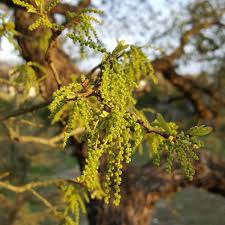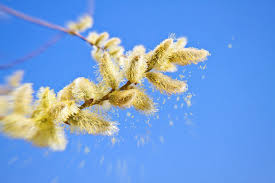
 Pollen is a substance produced by seed plants, consisting of pollen grains, which are highly reduced microgametophytes, which produce male gametes or sperm cells.
Pollen is a substance produced by seed plants, consisting of pollen grains, which are highly reduced microgametophytes, which produce male gametes or sperm cells.
Pollen grains have a hard coat made of sporopollenin that protects the gametophytes during the process of their movement.
Pollen grains move from the stamens to the pistil of flowering plants, or from the male cone to the female cone of gymnosperms.
Pollination is the process by which pollen grains are transferred from the male reproductive organ of a flower, the stamen, to the female reproductive organ, the pistil, of the same or a different flower, leading to fertilization and eventual seed and fruit production.
There are two main types of pollination: self-pollination and cross-pollination.
1. Self-pollination: In self-pollination, pollen from the anther, the male part, is transferred directly to the stigma,the female part, of the same flower or another flower on the same plant.
This occurs through various mechanisms such as wind, gravity, or physical contact with the reproductive parts of the flower.
Self-pollinating plants have both male and female reproductive organs within the same flower, allowing for efficient self-fertilization.
Cross-pollination: Cross-pollination occurs when pollen from the stamen of one flower is transferred to the stigma of a different flower, either on the same plant or a different plant.
This requires the assistance of external agents such as wind, water, animals insects, birds, bats, or humans.
Cross-pollination promotes genetic diversity and can result in healthier and more adaptive offspring.
The process of pollination involves the following steps:
1. Pollen release: The anthers produce and release pollen grains, which contain male gametes or sperm cells.
2. Pollen transfer: Pollen grains are transported from the anthers to the stigma by wind, animals, or other means of transport. Insects, for example, collect pollen on their bodies as they move from flower to flower.
3. Pollen germination: When a pollen grain reaches a receptive stigma, it germinates and develops a pollen tube that grows down through the style, connecting with the ovary.
4. Fertilization: Once the pollen tube reaches the ovary, the male gametes, sperm cells, travel through the tube and fertilize the female gamete, egg cell, in the ovule.
This fertilization results in the formation of seeds.
5. Seed and fruit development: Fertilization leads to the development of seeds within the ovary.
The ovary may also develop into a fruit that encloses the seeds, aiding in seed dispersal.
The process of pollination ensures the transfer of genetic material, promotes plant reproduction, and contributes to the diversity and survival of plant species.
If pollen germinates when it lands on a compatible pistil or female cone, producing a pollen tube that transfers the sperm to the ovule containing the female gametophyte.
Pollen in plants is used for transferring haploid male genetic material from the anther of a single flower to the stigma of another in cross-pollination.
In a case of self-pollination, this process takes place from the anther of a flower to the stigma of the same flower.
Pollen is infrequently used as food and food supplement.
Pollen itself is not the male gamete.
It is the gametophyte, which then produces the male gamete.
Each pollen grain contains vegetative, non-reproductive cell(s) only a single cell in most and a generative, reproductive cell.
In flowering plants the vegetative tube cell produces the pollen tube, and the generative cell divides to form the two sperm nuclei.
Pollen is produced in the microsporangia in the male cone of a conifer or other gymnosperm or in the anthers of an angiosperm flower.
Pollen grains have varied shapes, sizes, and surface markings characteristic of the species.
Pollen grains of pines, firs, and spruce tree are winged.
The smallest pollen grain, forget-me-not is 2.5-5 µm (0.005 mm) in diameter, while Corn pollen grains are large, about 90–100 µm.
Most grass pollen is around 20-25 µm.
Mature pollen grain has a double wall.
The pollen wall protects the sperm while the pollen grain is moving from the anther to the stigma.
The pollen wall protects the vital genetic material from drying out and solar radiation.
Pollen grain surfaces are covered with waxes and proteins.
The outer pollen wall, which prevents the pollen grain from shrinking and crushing the genetic material is composed of two layers.
Gymnosperm pollen grains often have air bladders, or vesicles, called sacci, which are sponge-like, and increase the buoyancy of the pollen grain and help keep it aloft in the wind.
Pollen can be monosaccate, or bisaccate.
The transfer of pollen grains to the female reproductive structure, the pistil in angiosperms is called pollination.
This transfer can be mediated by the wind (anemophilous literally wind-loving).
Anemophilous plants typically produce great quantities of very lightweight pollen grains, sometimes with air-sacs.
Non-flowering seed plants, such as pine trees, are characteristically anemophilous.
Anemophilous flowering plants generally have inconspicuous flowers.
Entomophilous, or insect-loving plants produce pollen that is relatively heavy, sticky and protein-rich, for dispersal by insect pollinators attracted to their flowers.
Many insects and some mites are specialized to feed on pollen,.
When placed on the stigma of a flowering plant, a pollen grain puts forth a pollen tube, which grows down the tissue of the style to the ovary, and makes its way along the placenta, guided by projections or hairs, to the micropyle of an ovule.
The sperm cells are carried to their destination in the tip of the pollen tube.
Nasal allergy to pollen is called pollinosis.
Allergy specifically to grass pollen is called hay fever:allergic rhinitis.
Generally, pollens that cause allergies are those of anemophilous plants, meaning pollen is dispersed by air currents.
Anemophilous plants produce large quantities of lightweight pollen.
The dispersal of pollen is random and the likelihood of one pollen grain landing on another flower is small.
Pollen can be carried for great distances and are easily inhaled, bringing it into contact with the sensitive nasal passages
Pollen allergies are common in polar and temperate climate zones, where production of pollen is seasonal.
In the tropics pollen production varies less by the season, and allergic reactions less.
Most late summer and fall pollen allergies are probably caused by ragweed, a widespread anemophilous plant.
Anemophilous spring blooming plants such as oak, birch, hickory, pecan, and early summer grasses may also induce pollen allergies.
Most cultivated plants with showy flowers are entomophilous and do not cause pollen allergies.
Symptoms of pollen allergy include sneezing, itchy, or runny nose, nasal congestion, red, itchy, and watery eyes.
Pollen that causes allergies can trigger asthma.
A study found a 54% increased chance of asthma attacks when exposed to pollen.
The number of people in the United States affected by hay fever is between 20 and 40 million, including around 6.1 million children.
Hay fever allergy has proven to be the most frequent allergic response in the nation.
Hay fever affects about 20% of Canadians and the prevalence is increasing.
People who suffer from eczema or are asthmatic tend to be more susceptible to developing long-term hay fever.
Pollen seasons have getting longer and more pollen-filled, and climate change is responsible.
Roughly half of the lengthening pollen seasons and 8% of the trend in pollen concentrations to climate changes driven by human activity.
The best way handle a pollen allergy is by preventing contact with the material.
Treatment:
Antihistamines are effective at treating mild cases of pollinosis; this type of non-prescribed drugs includes loratadine, cetirizine and chlorpheniramine.
Antihistamines do not prevent the discharge of histamine, but they do prevent a part of the chain reaction activated by this biogenic amine, which considerably lowers hay fever symptoms.
Decongestants can be administered in different ways such as tablets and nasal sprays.
Allergy immunotherapy treatment involves administering doses of allergens to accustom the body to pollen, inducing specific long-term tolerance.
Allergy immunotherapy can be oral, as sublingual tablets or sublingual drops, or by subcutaneous injection.
Most major classes of arthropods eat pollen, despite the common perception that bees are the primary pollen-consuming arthropod group.
Many Hymenoptera other than bees consume pollen as adults.
Pollen is an important source of food for several species of spiders.
Some predatory mites, some beetle families, many adult flies, some species of fungus eat/ingest pollen.
Bats, butterflies and hummingbirds do not pollen, but their consumption of nectar in flowers is an important aspect of the pollination process.
Bee pollen is a food ingredient and as a dietary supplement, the largest constituent of which is carbohydrates, with protein content ranging from 7 to 35 percent depending on the plant species collected by bees.
Honey produced by bees from natural sources contains pollen derived p-coumaric acid, an antioxidant and natural bactericide.
Except for allergies there are no harmful effects of bee pollen consumption.
A multitude of viruses and eukaryotic parasites are present in the pollen.
Pollen can tell a lot about where a person or object has been, because regions of the world, or even more particular locations such a certain set of bushes, will have a distinctive collection of pollen species.
Pollen analysis can reveal the season in which a particular object picked up the pollen.
